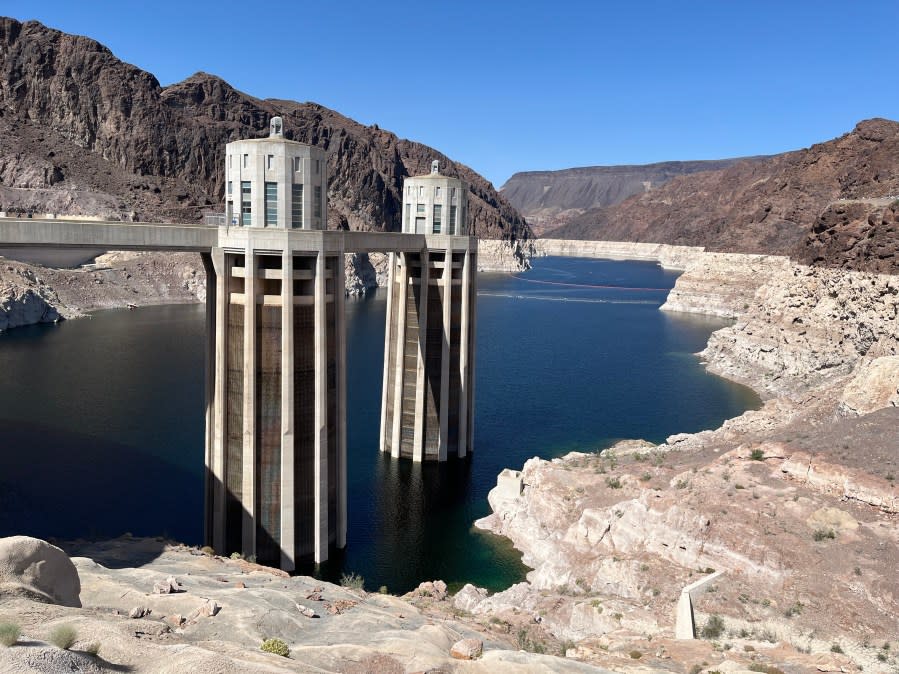LAS VEGAS (KLAS) — A Tier 1 water shortage will remain in effect for 2025, the U.S. Bureau of Reclamation announced on Thursday.
Based on projections in a two-year forecast looking at lake levels for both Lake Powell and Lake Mead — the nation’s two largest reservoirs — officials determined that more severe restrictions on water use are not needed next year. Tier 1 is the least severe shortage condition.
Under Tier 1, Southern Nevada is allowed 279,000 acre-feet from the Colorado River. That’s 21,000 acre-feet below the state’s standard allocation of 300,000 acre-feet — a 7% cut. It’s the same amount of water the state is getting in its 2024 allocation. An acre-foot is 325,851 gallons — literally, the amount needed to cover an acre with a foot of water. That’s enough to supply two to three households for a year.
Nevada doesn’t use its full allocation and hasn’t for years as conservation efforts have succeeded in cutting water use. Last year, Nevada only used about 188,000 acre-feet.

California will continue to get its full allotment — 4.4 million acre-feet — because Tier 1 reductions do not affect the state’s senior water rights. Arizona will receive about 1.9 million acre-feet, an 18% reduction on its full 2.4 million acre-foot allotment in normal years. Mexico will also go without its full allotment, with Tier 1 cutting that by 80,000 acre-feet (5%).
“The Colorado River System is already showing significant improvements as a result of water savings from the historic investments in conservation and infrastructure improvements through the Bipartisan Infrastructure Law and Inflation Reduction Act,” Reclamation Commissioner Camille Calimlim Touton said. “These investments provide funding to local, state, and Tribal communities to tackle the climate crisis and unprecedented drought conditions.”
Conservation groups criticized the Bureau’s statements in a news release in advance of the announcement.
“The Bureau is telling us to expect more big winters, but the data shows the Bureau keeps overestimating future flows,” said Eric Balken, executive director of the Glen Canyon Institute. “One or two bad winters and we are back in crisis mode at Powell and Mead. That is the real story.”
Record snowpack in 2023 helped refill Lake Powell and Lake Mead, which had dipped to about 25% capacity as the drought that started in 2000 took its toll.
The two-year projections for Lake Mead and Lake Powell appear below.
LAKE MEAD: The lake is currently at 1,062.11 feet (the elevation of the lake’s surface), about 33% full. Projections show the lake at 1,062.32 feet on Jan. 1, almost 13 feet below the threshold required to avoid Tier 1 restrictions.


LAKE POWELL: The lake is currently at 3,582.42 feet (the elevation of the lake’s surface), about 41% full. Projections show the lake at 3,574.08 feet on Jan. 1, about 84 feet above minimum power pool but 126 feet below full pool.


Touton was in Las Vegas this week as U.S. Rep. Susie Lee hosted the 2024 Water Summit. She said Nevada has provided “proof of concept” for the rest of the states in the Colorado River Basin with its aggressive conservation efforts that include rebates for the removal of grass at homes and businesses, as well as recycling that captures all water used indoors. The Southern Nevada Water Authority is taking that a step further as they work to eliminate septic tanks and connect homes to the sewer system.


The Water Summit provided a platform for officials to praise federal and local efforts to improve infrastructure in Nevada and downstream in California, where a new water recycling program is modeled on what Nevada has been doing for years.
“The Bureau’s rosy projections send the wrong message to the public during the hottest 12-month stretch on record,” said Kyle Roerink, executive director of the Great Basin Water Network. “The federal government’s short-term reports create a negative feedback loop that papers over the likelihood of forthcoming dry water years and doubles down on piein-the-sky thinking for reservoir management.”
Copyright 2024 Nexstar Media, Inc. All rights reserved. This material may not be published, broadcast, rewritten, or redistributed.
For the latest news, weather, sports, and streaming video, head to KLAS.
Source Agencies

